How The Rings of Power crafted that stunning battle sequence
- Oops!Something went wrong.Please try again later.
- Oops!Something went wrong.Please try again later.
- Oops!Something went wrong.Please try again later.
The crew behind The Lord of the Rings: The Rings of Power knows you've seen a lot of pop culture battles. The fantasy and history genres are littered with epic skirmishes, some memorable, some less so. So, when it came time to craft their version of a massive battle in the pivotal season 1 episode "Udûn," they knew they had to aim big.
"We watched a lot of battle scenes in different movies, and you realize that a bunch of sword-fighting, slashing, and killing gets old pretty fast," cinematographer Alex Disenhof tells EW. "We've all seen it before as viewers, and we knew that if we just had a nondescript battle, it would get stale. So, we broke it down into individual skirmishes and moments for each hero character."
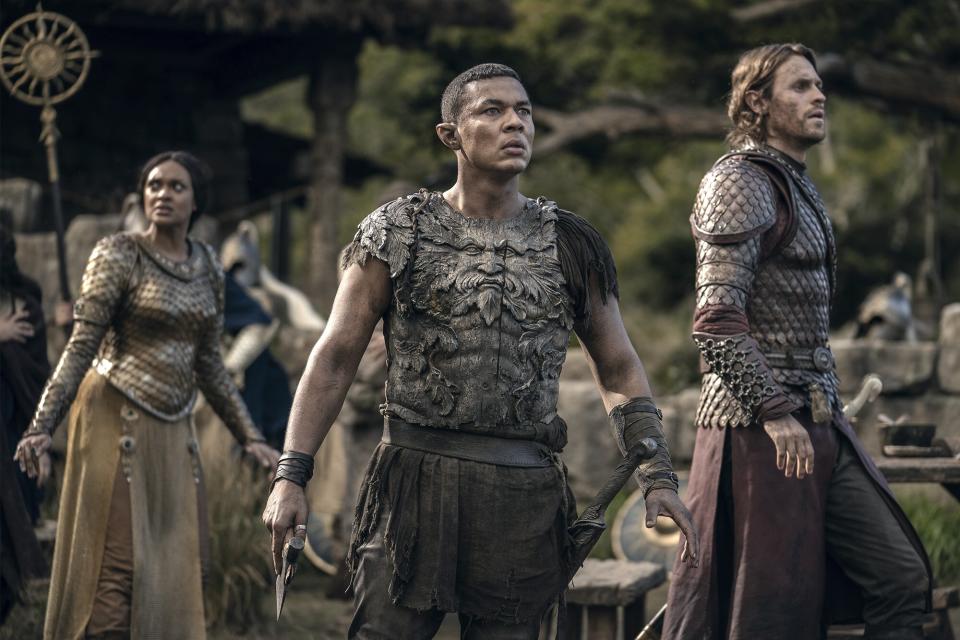
Matt Grace/Prime Video Cynthia Addai-Robinson, Ismael Cruz Córdova, and Charlie Vickers on 'The Lord of the Rings: The Rings of Power'
Here, some of the filmmakers behind The Rings of Power's biggest episode break down how they crafted that epic battle sequence — from complicated stunt work to careful cinematography. Directed by Charlotte Brandstrom, the episode is entirely centered in the Southlands of Middle-earth, where elf Arondir (Ismael Cruz Córdova) and human Bronwyn (Nazanin Boniadi) lead a scrappy band of villagers as they fight back against a horde of invading orcs. Later, the regal Númenórean cavalry arrives, led by Cynthia Addai-Robinson's queen-regent Míriel, setting up a grand clash on horseback.
It's a massive moment, where multiple story lines converge for the first time. Much of the action is centered in the Southlands village, and the production team constructed the set from scratch, nestled into a bucolic valley in New Zealand. Legendary stunt coordinator and second unit director Vic Armstrong remembers wandering around the set while it was still being built, sketching out action sequences in his head. "That's the moment I like best, getting creative and dreaming up ideas," he says with a smile. "It's like you have to deliver a big cake, and the location tells you what the ingredients are, so you can build up to that lovely tasty cake at the end."
Into the dark
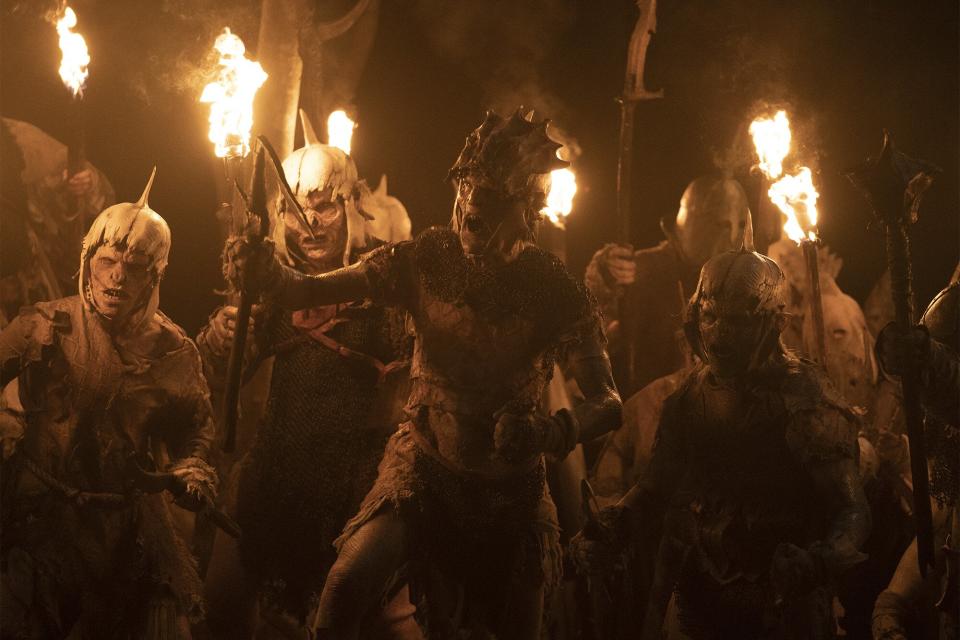
Prime Video Orcs gather on 'The Lord of the Rings: The Rings of Power'
Much of the episode takes place at night, and one of Disenhof's biggest challenges was lighting. The story called for several scenes to be lit purely by moonlight, until a crew of orcs marches in, carrying flaming torches. The crew rigged multiple construction cranes and cherry pickers with overhead lights, with Disenhof underexposing the camera to find the perfect balance. (As for the torches themselves, each torch would only burn for about a minute, leaving Disenhof with limited time to capture the perfect shot.) The key, he says, was evoking the right mood without sacrificing visibility.
"There's been some recent moments where people have complained about things being too dark on TV," Disenhof adds. "I feel for the cinematographers who have been caught in that because it's a hard balance. You want it to feel dark and scary, but you also have to remember that the most important thing is for the story to be told in a clear way. So, what I tried to do was maintain that level of darkness as much as I could, but not to the point where the viewer had to squint to know what was going on."
Disenhof also points to one sequence as being particularly tricky: when Córdova's Arondir falls off a roof and comes face to face with a giant, hulking orc. Armstrong came up with the idea for that scene, taking inspiration from similar David-versus-Goliath fights in films like Butch Cassidy and the Sundance Kid and Raiders of the Lost Ark. (Armstrong, of course, has first-hand knowledge of the Indiana Jones franchise, having worked for years as Harrison Ford's stunt double.)
Armstrong also worked closely with Córdova and other cast members to help each develop a unique fighting style, helping to differentiate the regal elves from the more military-trained Númenóreans. As an ageless and athletic elf, Arondir has a more natural, graceful way of moving, and Córdova found inspiration in different types of martial arts, from wushu to capoeira.
"It's a nice moment when Ismael realizes the size of the guy and looks up at this great monster, who picks him up by the neck and throws him through a fence," Armstrong adds with a laugh. "Ismael did a huge amount of that and got beaten up pretty good. It's like when you do a film with Harrison Ford or Tom Cruise: They are in there doing their action. That's what I wanted Ismael to do. I think he's going to be a superstar. He's got great charisma, and you really believe he's in there getting hit — and he was."
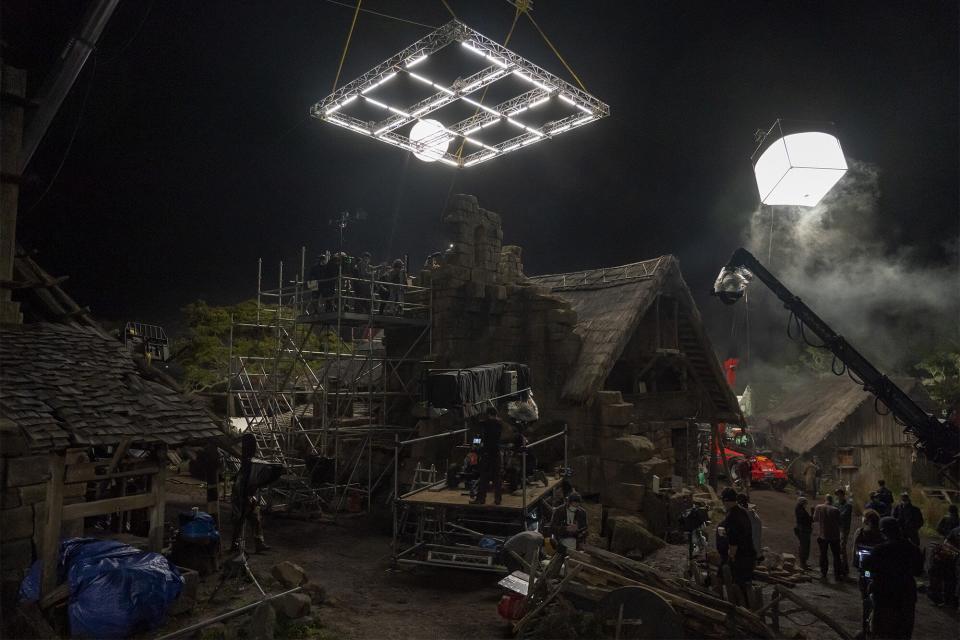
Matt Grace/Prime Video Behind the scenes of 'The Lord of the Rings: The Rings of Power'
Even though Córdova was doing most of the hand-to-hand combat, that brief fight against the giant orc took intense collaboration from every single department. The stunt team rehearsed for weeks, figuring out the perfect fall angle from the roof. The art department buried mats in the ground to help soften the landing, hiding them carefully from the camera. When Disenhof noticed that the roof of the building itself was reflecting too much light, set decorators worked to hand-paint the roof black. Meanwhile, the special effects team was on hand to oversee the smoke and explosions, while the visual effects team came in later to smooth out every tiny detail.
"Filmmaking is really community art-making," Disenhof adds. "You take this huge group of people who are all specialists and amazing at what they do, and we all come together with a common goal. A film set like this is constant chaos and madness, and somehow, magic happens."
Giddy-up!
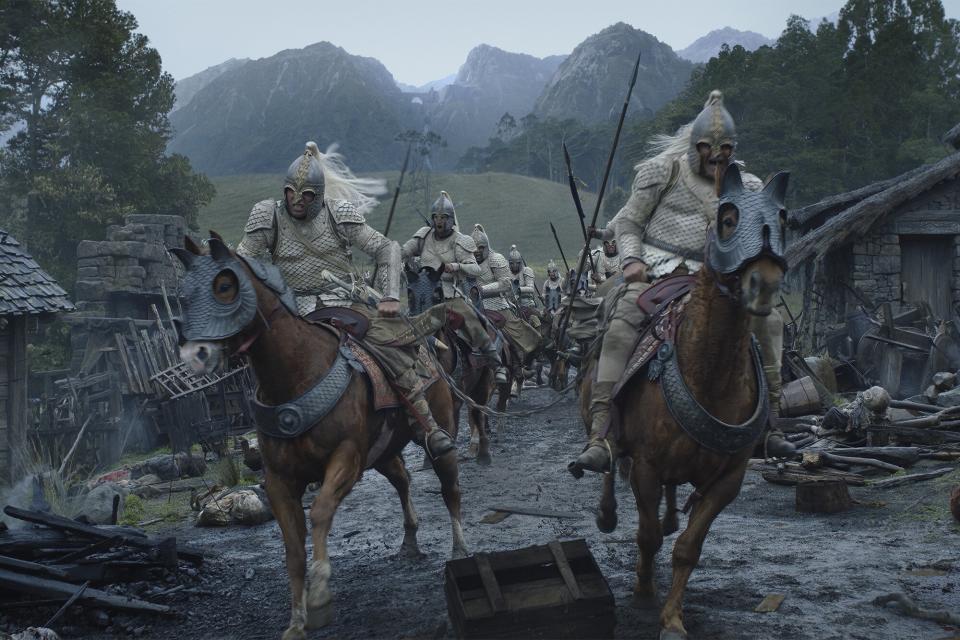
Matt Grace/Prime Video The cavalry arrives on 'The Lord of the Rings: The Rings of Power'
Later in the episode, the Númenórean cavalry arrives at dawn, charging the orcs on horseback. VFX producer Ron Ames describes it as a "classic British horse battle," and the entire sequence was meticulously planned. Instead of constructing big moments later in post-production, the goal was to capture as much practical action as possible on the day, from flying arrows to stuntmen falling off of horses. Then, the visual effects team would come in to enhance the scene, adding background riders or smaller details to help make the Númenórean army seem bigger.
"Often what happens in a circumstance like this is that [the visual effects team] get the footage, and we go, 'Oh my God, how are we going to fix this?'" Ames adds. "It wasn't like that. It was really intentionally done."
Mother Nature also had to cooperate. Armstrong wanted the Númenóreans to arrive right at dawn, a brief moment of light after a long night of darkness. That meant the crew had a limited time to capture the big charge.
"I shot it as the sun was peaking on the horizon," Armstrong remembers. "We got so lucky because sometimes you've got 40 or 50 horses, and you've been up since 3 o'clock in the morning to get that one moment. It's not the sort of thing you can rehearse. We'd rehearsed it days before, but shooting on the day is always difficult. You're getting your cameras in position in the pitch black, but we got it absolutely bang on the money as the dawn was coming up."
An explosive finale
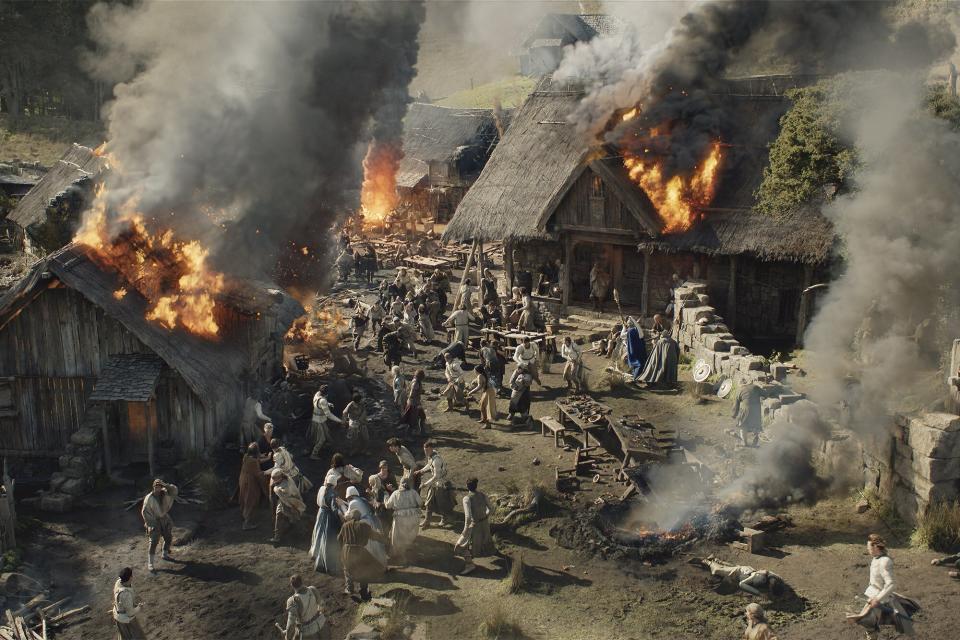
Prime Video Behind the scenes of 'The Lord of the Rings: The Rings of Power'
The biggest moment comes at the end of the battle, after the heroes have seemingly triumphed over the orcs. Elves, humans, and Númenóreans alike all gather for a celebratory feast, only to realize too late that the enemy has triggered a volcanic eruption nearby — the devastating birth of Mount Doom.
For that moment, Disenhof wanted to emphasize brighter colors and midday sunlight to contrast the earlier dark battle scenes. "We wanted to shoot all of our characters in their post-battle moments of reflection and celebration," he explains. "We have all these groups coming together, and we wanted it to be a surprise when the tables turned one last time. I thought it was an interesting creative choice to make this environmental disaster happen in a very sunny, bright, and idyllic setting."
Many of the explosive effects were captured in-camera — like the fireballs descending from the sky or the huge geysers of water shooting up from the ground. Ames notes that despite the series' fantasy setting, he and the visual effects team wanted everything on screen to feel rooted in reality, describing the goal as "mysterious" but never "magical." He compares the episode's pacing to a piece of music — and the volcano is the grand finale.
"We tried to make that seem as real as possible," he adds. "We pulled footage from real volcanoes. We studied Pompeii. We looked at all the history of that kind of geological destruction. Our goal was to make it look like a documentary."
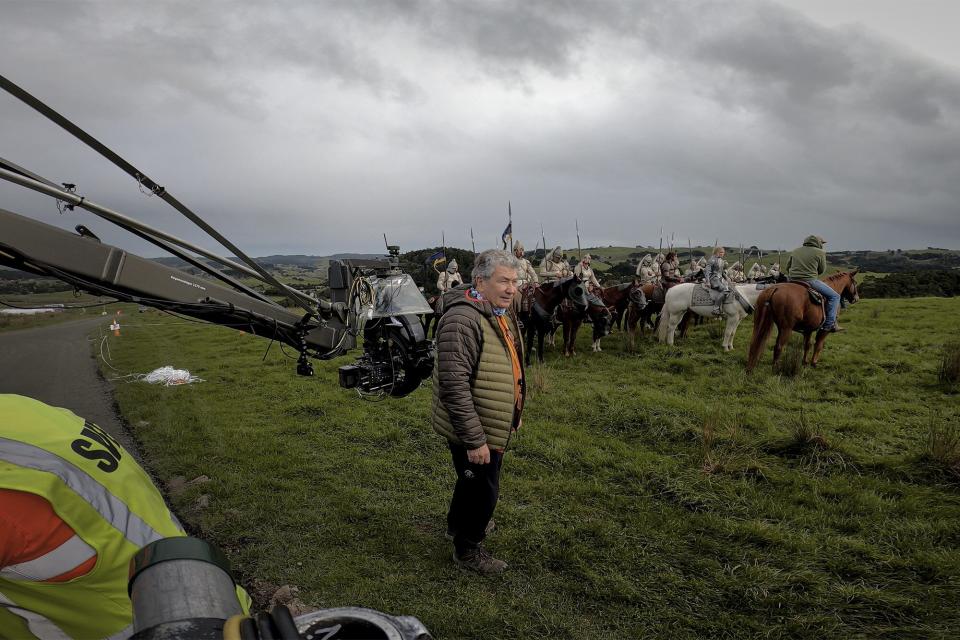
Prime Video Stunt coordinator and second unit director Vic Armstrong on the set of 'The Lord of the Rings: The Rings of Power'
The entire episode was a massive undertaking — but the filmmakers say it was worth the effort. Armstrong remembers watching the Númenórean cavalry descend the hill for the first time, reveling in how all that collaboration paid off.
"The horse people are there at 3 in the morning getting ready, and the orcs are there at 3 in the morning getting all that awful makeup put on and their eyepieces put in," Armstrong explains. "Everything has to be scheduled and timed for when their wardrobes are ready. Then, you have to give the special effects team time to make stuff. It's a huge logistical task with every department. And I get a great kick out of it when I'm the guy shouting action and causing all that to happen!"
heck out more from EW's The Awardist, featuring exclusive interviews, analysis, and our podcast diving into all the highlights leading up to all the major award shows.
Related content:

